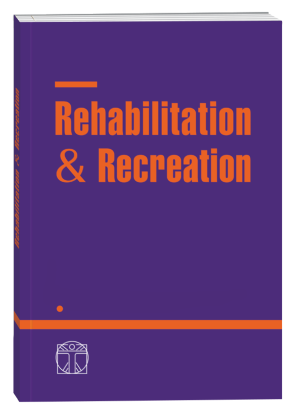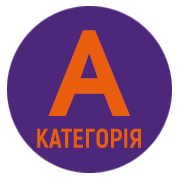RESTORATION OF MOBILITY IN THE JOINTS IN PERSONS AFTER BRAIN CONTUSION BY MEANS OF PHYSICAL CULTURE AND SPORTS
DOI:
https://doi.org/10.32782/2522-1795.2023.14.32Keywords:
traumatic brain injury, goniometry, corrective rehabilitation program.Abstract
The consequences of acquired blast traumatic brain injury can have a significant impact on postural instability and gait pattern. The development of programs using the means of physical culture and sports rehabilitation after an explosive injury is a fundamental stage in the return of a person to ordinary life, and later to amateur sports. Purpose of the study was to introduce the developed correctional rehabilitation program for men aged 25–42 after a combat injury and to assess the dynamics of the functional state of the musculoskeletal system. Materials. Under observation were 38 men aged 25–42 years with long-term consequences of a closed craniocerebral injury in the late long-term period. The patients were randomly divided into two groups: Gr.1 (n=20) and Gr. 2 (n=18). All patients were involved in amateur sports before injury. The results. The rehabilitation recovery program was composed of normative and variable components with a duration of 21 days. For persons Gr.1 (n=20) a correctional rehabilitation program was developed, patients Gr. 2 (n=18) were trained according to the established rehabilitation scheme of the Ukrainian Research Institute of Prosthetics, Prosthesis Construction and Restoration. The established Smart goals for the studied patients of both groups were the same: restoration of the range of motion in the joints of the lower extremities to the normative value. The author’s program included training according to the Neurac method on the Redcord suspension system, instead of a general workout on a multifunctional block simulator; Nordic walking instead of training walking; vestibular gymnastics. To determine the result of the rehabilitation intervention, goniometric studies of the range of motion of the hip, knee and ankle joints were performed. The faces of Gr. 1 (p<0.05) and Gr. 2 (p>0.05) all the studied indicators increased, but have not yet reached the level of the standard value. Conclusions. Thus, the study showed the advantages of the author’s program, the implementation of which resulted in an improvement in goniometric parameters in patients with Gr. 1 because the statistical significance was (p<0.05).
References
Ашрафутдінова В. А., Вихляєв Ю. М. Відновлення рухливості суглобів у спортсменів після травм ОРА засобами фітнесу і фізичної терапії. Науковий часопис НПУ ім. М.П.Драгоманова. 2019. 11 (119). 97. С. 9–12.
Воронова В. Я., Лазарєва О. Б., Ковельська А. В., Кобінський О. В. Сучасні підходи до застосування засобів фізичної терапії, спрямованих на відновлення постурального контролю та ходьби в осіб з наслідками черепно-мозкової травми. Спортивна медицина, фізична терапія та ерготерапія. 2021. № 1. С. 57–63.
Забенько Є. Ю., Атамас А. В., Півнева Т. А. Легка черепно-мозкова травма: загальна характеристика, нейродегенеративні наслідки та моделювання. Фізіол. журн. 2017. Т. 63. № 3. С. 80–89.
Коршняк В. О., Насібуллін Б. А. Сучасні погляди на механізми впливу вибухової хвилі на центральну нервову систему та формування неврологічної симптоматики. Міжнародний неврологічний журнал. 2016. № 6. С. 139–142.
Місюра В. Б., Рубан Л. А., Мішин М. В. Вестибулярна реабілітація спортсменів-аматорів після контузії головного мозку. Реабілітаційні та фізкультурно-рекреаційні аспекти розвитку людини (Rehabilitation & recreation). 2022. № 12. С. 198–203.
Місюра В. Б. Стан балансу, функціональної рухливості та біомеханічні параметри ходьби чоловіків 25–42 років із наслідками бойової травми. Науковий часопис НПУ імені М.П. Драгоманова. 2023. № 2(160).
Рубан Л., Місюра В. Якість життя, вестибулярна дискоординація та порушення паттерну ходьби спортсменів-аматорів з віддаленими наслідками черепно-мозкової травми. Науковий часопис НПУ імені М.П. Драгоманова. 2022. 8(153). С. 75–79.
Швець А. В., Кіх А. Ю., Лук’янчук І. А. Особливості відновлення постконтузійної симптоматики після черепно-мозкової травми у військовослужбовців. Запорожский медицинский журнал. 2019. 21. № 5. С. 618–624.
Alsalaheen B, Stockdale K, Pechumer D, Broglio SP, Marchetti GF. A Comparative Meta-Analysis of the Effects of Concussion on a Computerized Neurocognitive Test and Self- Reported Symptoms. J Athl Train. 2017 Sep; 52(9):834–846. doi: 10.4085/1062-6050-52.7.05
Batulenko V. I., et al. Альтернативні підходи до фізичної реабілітації наслідків бойової черепно-мозкової травми в учасників операції об’єднаних сил. Медсестринство. 2020. 3. С. 44–46.
Biloshytskyi V. V., et al. Оптимізація когнітивної нейрореабілітації пацієнтів iз бойовими травматичними ураженнями головного мозку. International neurological journal. 2016. 5.83. P. 70 75.
Honcharov A., Ruban L., Litovchenko A., Okun D., Turchinov, A. Physical therapy for oldtimer athletes with chronic back pain. Physiotherapy Quarterly. 2020. 28(2). P. 20 24.
Kuznetsov MV, Barashevskyi SA, Pirozhkov VI. Tradytsiini ta skhidni yedynoborstva u systemi fizychnoi pidhotovky VVNZ MO Ukrainy. Aktualni problemy rozvytku tradytsiinykh i skhidnykh yedynoborstv. Zb nauk pr X Mizhnar internet nauk–metod konf. Kharkiv : Natsionalna hvardiia Ukrainy. 2016. 10. P. 101–107.
Ruban L., Putiatina G., Tsyhanovska N. Influence of health-improving motor activity on the vegetative balance of older women. Slobozhanskyi herald of science and sport. 2021. 9(5). Р. 57–67. 15. RehabPrime: https://rehabprime.com/ goniometry/.
Downloads
Published
How to Cite
Issue
Section
License

This work is licensed under a Creative Commons Attribution-NonCommercial-NoDerivatives 4.0 International License.












